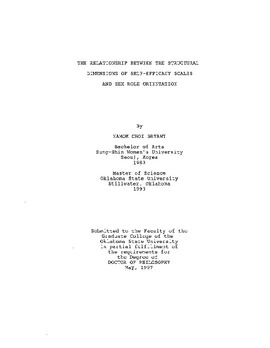| dc.contributor.advisor | Barnes, Laura | |
| dc.contributor.author | Bryant, Namok Choi | |
| dc.date.accessioned | 2016-04-07T17:57:48Z | |
| dc.date.available | 2016-04-07T17:57:48Z | |
| dc.date.issued | 1997-05 | |
| dc.identifier.uri | https://hdl.handle.net/11244/33225 | |
| dc.description.abstract | Scope and Method of Study: The major purpose of the study was to investigate the relationship between the structural dimensions of self-efficacy measures and sex role orientation. Participants (N = 651) in the study were undergraduate students enrolled in an introductory psychology course at a large midwestern university. Participants voluntarily completed the Multidimensional Self-Efficacy Scales (MSES), the Self-Efficacy Scale (SES), Bern Sex Role Inventory, Personal Attributes Questionnaire, and Demographic Information Questionnaire. Principal axis factor analysis with oblique rotation was first utilized to examine the structural dimensions of the MSES and the SES. Canonical correlation analyses and multiple regression analyses were, then, performed to explicate the relationships between the two constructs. | |
| dc.description.abstract | Findings and Conclusions: A nine-factor oblique solution for the MSES and a two-factor oblique solution for the SES were determined to best reflect the structural dimensions of the self-efficacy measures. Subsequent canonical correlation analyses indicated that there were statistically significant relationships between the self-efficacy measures and sex role measures (Rc=.72 with the MSES, Rc=.71 with the SES). The obtained regression equations further indicated that MSES factors representing masculine attributes, such as the self-assertive efficacy factor, were the most significant predictors of masculinity, whereas MSES factors representing feminine attributes, such as the meet others' expectation efficacy factor, were the most significant predictors of femininity. | |
| dc.format | application/pdf | |
| dc.language | en_US | |
| dc.rights | Copyright is held by the author who has granted the Oklahoma State University Library the non-exclusive right to share this material in its institutional repository. Contact Digital Library Services at lib-dls@okstate.edu or 405-744-9161 for the permission policy on the use, reproduction or distribution of this material. | |
| dc.title | Relationship between the structural dimensions of self-efficacy scales and sex role orientation | |
| dc.contributor.committeeMember | Fuqua, Dale | |
| osu.filename | Thesis-1997D-B915r.pdf | |
| osu.accesstype | Open Access | |
| dc.type.genre | Dissertation | |
| dc.type.material | Text | |
| thesis.degree.discipline | Applied Behavioral Studies | |
| thesis.degree.grantor | Oklahoma State University | |
